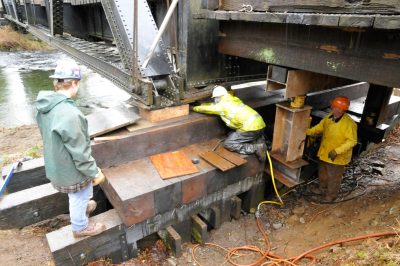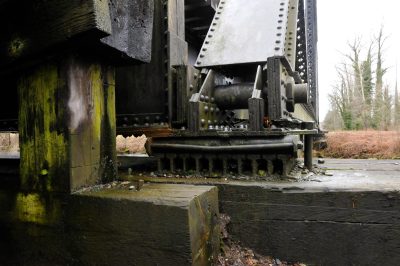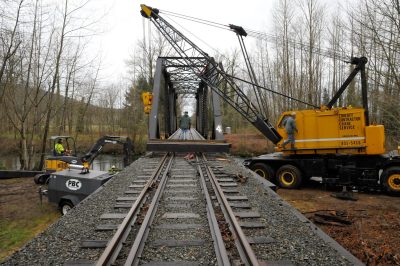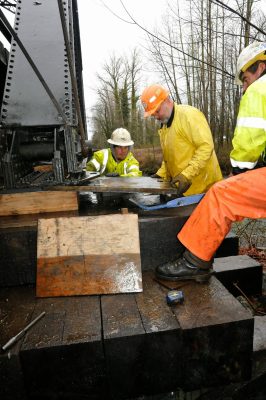It started out as a small project for the 1891-built Bridge 35: replace several timbers under the Pratt truss that had detectable deterioration or evidence of crushing. Simultaneously, bearing pads – in this case, a nest of steel rollers – that are designed to allow the bridge to freely expand and contract were frozen and were also scheduled for replacement. In preparing for the work, it was noted that the pony truss that supports the timber trestle approach to the steel span was not properly pinned and had unequal spacing of the posts so it was also scheduled for replacement.
Performing comparatively minor bridge work is expensive for many of the reasons noted in the last blog post, but also for the cost of mobilizing the specialized equipment to perform the work. Any opportunity to combine two or more tasks into one project generally yields substantial cost savings. So the scope of work was set: change timber caps and girders, replace bearing pads, and replace the pony bent. For Bridge 35, this should have been four days’ work but unfortunately not everything goes according to plan.
Work began on a typical spring day in the Northwest: wet and cool. Initially, the bridge lifted without incident and the old roller nests were removed. Timber replacement began and then something started to go wrong: a weld in the steel added to support the jacking arrangement failed and two steel angles near the jacking area began to fail. The bridge slowly descended approximately 6 inches onto the pier. Fortunately, no one was hurt and there was no serious damage. However, this was another timely reminder about how challenging it can be working with a structure designed and built more than 125 years ago. And because it is “safety first,” this minor damage will be repaired before any passenger trains operate over the bridge, even though this will affect the first trains of the year.
The next step was to get a crane on site to lift the bridge up. (Special thanks to King County for granting permission to drive up the levee on just six hours’ notice!) Imhoff’s 65-ton Pierce American answered the call and arrived first thing the next morning. Owner/operators Scott and Tammy Imhoff are familiar with the Museum and its unique needs – this is the same crane that was used to build bridge 31.3 at Snoqualmie Falls, lift the chapel car and Great Northern caboose off heavy haul truck decks, and change wheels or trucks on a number of Museum cars and locomotives.

New copper-treated timbers are in place, and now workers are installing the new base, soul plate, and bearing pad on the south side of the east pier.
The east pier consists of large timbers typically 14 inches square and a length to suit their purpose. Timber girders are eight feet long and caps are longer. Originally, the caps were 26 feet long, but the replacements will be split, using two 12-foot timbers to perform the same function. This is more economical, and they are easier to handle. Timbers are pinned in place, but only as required because each hole is an opportunity for moisture and oxygen to get into the wood. All the new wood is treated with copper naphthenate and was supplied by Wheeler Lumber in South Dakota. While creosote is preferred by the rail industry, permitting agencies in Washington State generally make it difficult (or impossible) to use because they are concerned about residue that might contaminate the river sediment. Copper naphthenate is comparable in performance to creosote and is now accepted by the Railway Tie Association for timber ties.
An important part of the project scope was replacement of the bridge bearing pads. The original steel roller nest was probably troublesome for much of the bridge’s history. Modern bridges often use a stainless steel and Teflon interface to address this need. On the advice of the bridge engineer, this design was adopted. In addition, bridges often sit on a fabric pad to help absorb vibration. Fabreeka pads consist of cotton duck laminations impregnated with neoprene which in a similar form have been in use since 1918. The Museum elected to have a Teflon coating laminated to the top of the Fabreeka pad.
With all the work except installation of the new pony bent complete, repair of the damaged steel angles is now the focus. New angle irons are being drilled to match the existing holes. They will be incorporated into the bridge as soon as their fabrication is complete. After these minor repairs are completed and the bridge is “double checked,” train service to North Bend will resume.




